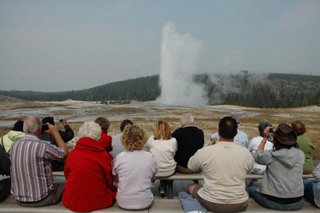
If there is hell on earth, it might be Yellowstone National Park.
Geysers, boiling mud caldrons and sapphire hot springs dot a silica-bleached landscape that appears to be burning. In truth the burn lies beneath, in a sizzling pool of magma just three miles below the surface. The acne-scarred earth above is eerie and haunting, and undeniably beautiful.
Yellowstone is home to 400 of the world’s 600 geysers. The most famous is Old Faithful, famous largely because of its predictability, but also because it is easily accessible, say park rangers. “A lot of people are in a hurry, and they can come see it and then move on,’’ said ranger Jeanne Kearney.
Every 92 minutes, give or take, Old Faithful spews forth it’s frustrations in a 2 ½ minute stream of steamy invective, typically reaching heights of 130 feet.
Visitors gather 15 minutes in advance, numbering as many as 3,000 to 4,000 in peak summer months. Even on this hazy day when the sky is veiled by smoke from Montana wildfires to the north, there’s a sizeable crowd.
Old Faithful gives a few false starts – a sign that the pressurized water beneath the earth is about to push past the four-inch constriction through which the steam passes. Then “Oh!’’ cries the crowd as the geysers sprays high and hard. The water that hits bystanders has already cooled by the time it falls to earth.
Except for its regularity, Old Faithful is one of the least impressive geysers in the nation's oldest park. Some others blow harder and longer, like Castle, which blasts about every 13 hours for around 52 minutes.
The geysers are only olne of Yellowstone’s attractions. Buffalo, deer, moose and elk roam here. The views are wide and long, over lakes and ridges and through endless valleys cut by crystalline streams. At the park’s north end sits Mammoth Springs and it’s extraordinary travertine terraces created by years of mineral deposits from the thermal features.
Yellowstone is actually the caldera of a vast volcano that blew 640 million years ago, then collapsed, with its molten lava just beneath the surface. Some day soon it will likely blow again – though "soon" in geological terms can be a few million years or so. No need to worry.
Thursday, September 07, 2006
Old Faithful
Posted by
DARCOS CRUZ
at
8:23 AM
![]()
![]()
Subscribe to:
Post Comments (Atom)


1 comment:
Hi Jane, Lynn is helping me to find you on line so that I can read your news. Sounds like you are having fun. Love Tew
Post a Comment